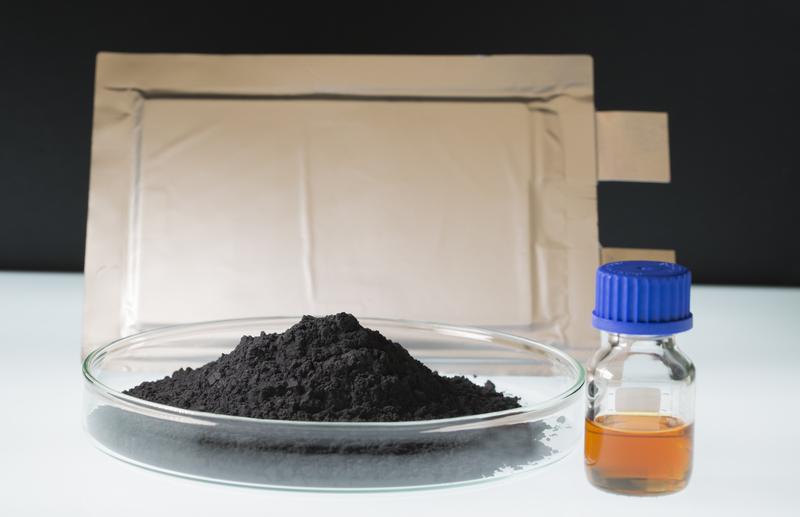
Launch of project ECO COM'BAT: Sustainable energy storage with high-voltage batteries

Efficient lithium-ion pouch cell with the base materials.
© K. Selsam-Geißler, Fraunhofer ISC
Lithium-ion batteries are the preferred source of energy for electric vehicles and consumer devices owing to their high energy density and reliability. But expectations rise with green car sales and consumer devices grow more and more complex. Consumers ask a lot from a new battery: better safety, longer life spans, higher energy density, better performance and wider range.
The scientists teaming up in the project ECO COM'BAT („Ecological Composites for High-Efficient Li-Ion Batteries“) set out to develop a novel type of high-voltage battery. Their goal is to extend the range of electric vehicles, to shorten charging times, to reduce battery weight, to enhance stability and durability, and above all, to substitute critical or precious raw materials commonly used in conventional lithium-ion batteries.
Upscaling to production scale
In order to achieve all this at the same time, the project partners use innovative materials: low-cobalt NMC – short for lithium nickel manganese cobalt oxide – serves as active electrode material. It provides the required energy density but contains approx. 20 percent less cobalt than conventional solutions. Carbon nanotubes and porous carbon serve as conductive additives.
They enhance the electrical conductivity of the electrodes and allow high energy densities. A special high-voltage electrolyte based on the conductive salt lithium-bis(fluorosulfonyl)imide (LiFSI) serves as electrolyte which can be operated stably even at high voltages. An ion-conductive hybrid polymer coating protects the electrolyte materials and ensures safe and reliable use of the battery and a long lifespan.
The first task for the ECO COM'BAT team will be the upscaling of the processes required for the large-scale production of the new battery materials. The next step will then be the upscaling of the actual cell production to close-to-industry pilot scale and then to production scale. The challenge is to meet automotive standard requirements with energy and cost efficient production methods.
Efficient gentle recycling
A more widespread use of electric vehicles will invariably mean more waste batteries. To prevent problematic waste and also to recover precious materials like graphite, cobalt and lithium, new strategies must be developed to ensure efficient recycling. This begins with a design for recycling that allows to recover the contained materials to the best possible extent. To this effect, the researchers will also test innovative recycling processes.
Project partners and funding
The ECO COM'BAT project is supported by the EIT RawMaterials consortium of the European Institute for Innovation and Technology EIT. EIT RawMaterials, funded by the European Commission, is the world's largest and strongest consortium in the raw materials sector. Its vision is a European Union, where raw materials are a major strength. The task of the consortium is to strengthen the competitiveness, growth and attractiveness of the European raw material sector through radical innovation and entrepreneurship.
The innovative materials of the high-voltage battery will be provided by the industry partners Arkema, from France, and Umicore, from Belgium. The Fraunhofer ISC will be in charge of the required protective coating. Arkema and the Fraunhofer ISC will work together on upscaling of materials to pilot scale. The electrodes and cells will be manufacured by the French Alternative Energies and Atomic Energy Commission (CEA), the German manufacturer Custom Cells Itzehoe and by the Fraunhofer R&D Center Electromobility Bavaria, part of the Fraunhofer ISC, according to specifications provided by the French battery maker SAFT. The analysis and characterization of materials, components and cells will be performed by the Technical University Darmstadt, the Spanish research organization CSIC, the Italian research organization ENEA, as well as the Fraunhofer ISC and its Project Group IWKS. All simulation processes will be done at the Flemish Institute for Technological Research VITO. The Fraunhofer Project Group IWKS will manage all tests on new recycling strategies.
http://www.isc.fraunhofer.de
http://www.iwks.fraunhofer.de
http://www.eitrawmaterials.eu












